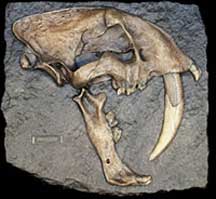The saber-toothed cat, Smilodon, was a predator that roamed North and South America during the Pleistocene Epoch. Smilodon first appeared on the fossil record about 2 million years ago and apparently became extinct about 10,000 years ago at the end of the last Ice Age. Smilodon is an ancestor of modern cats and was approximately the same size as an African lion, but more powerfully built. Sporting a pair of seven inch canine teeth, Smilodon undoubtably was a powerful predator capable of taking large prey.
The largest concentration of fossils from this species, Smilodon fatalis, were found in the Ranch La Brea tar pits in Los Angeles, California. At Rancho La Brea (approximately 40,000 years ago to 4,000 years ago) deposits of tar would seep out of the ground and form pools. These sticky pools of tar created a unique natural trap for animals. Like most predators, Smilodon would sometimes scavenge the remains of animals. When scavenging at Rancho La Brea, predators risked being lured into the tar and becoming trapped. Smilodon fatalis is second only to the dire wolf in the number of fossils from the tar pits. Other fossil evidence found there implies that humans and saber-toothed cats may have briefly coexisted at Rancho La Brea.
Although the evolutionary occurrance of saber-teeth is an interesting phenomenon, it is not entirely unique to Smilodon. During the last 60 million years or so, at least four different orders of mammals developed saber-teeth independently of each other on three different continents. In spite of their different lineages they share some common characteeristics. Most were built for ambushing rather than chasing down their prey. To accomodate their large teeth, most saber-toothed animals could open their mouths in a gape of 90-degrees or more. This is impressive compared to the 70 degree gape of modern cats.
The ambush-style of hunting, enlarged canines, and wider gape suggests that Smilodon hunted large prey animals with thick hides. Since the saber-teeth of Smilodon would have shattered upon impact with bone, the canines were probably used to pierce the throat of soft underbelly of its prey. Possible prey animals of the Smilodon include mammoths, mastodons, American versions of the camel and horse, bison, and giant ground sloths. Smilodon probably became extinct when the large animals it hunted died out.
Smilodon fatalis 
Quantity in Basket: None
Code: SCU-200
Price: $228.50
Shipping Weight: 3.16 pounds
Time: Pleistocene Epoch, 2 million years ago to 10,000 years ago
Location: Rancho La Brea Tar Pits, California, USA
Dimensions: 15" x 14" x 2-1/2"